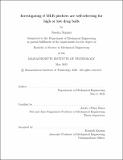| dc.contributor.advisor | Hosoi, Anette (Peko) | |
| dc.contributor.author | Sonner, Jessica | |
| dc.date.accessioned | 2022-08-29T15:57:23Z | |
| dc.date.available | 2022-08-29T15:57:23Z | |
| dc.date.issued | 2022-05 | |
| dc.date.submitted | 2022-06-14T19:35:37.811Z | |
| dc.identifier.uri | https://hdl.handle.net/1721.1/144584 | |
| dc.description.abstract | The drag coefficient of 4928 batted balls in the MLB in 2019 were measured and matched with 121 pitchers who threw the ball to examine if they are statistically more or less likely to select a high or low drag ball to throw. It was hypothesized that (1) pitchers are routinely selecting for either high or low drag balls, and (2) the regular selection of high drag balls are associated with "better performing" pitchers, or pitchers who have less home runs scored against them, as high drag balls travel less far through the air than low drag balls. However, it was found that pitchers in this data set do not appear to be selecting for higher or lower drag balls, and the average drag coefficient of the balls they select is not correlated with that of higher or lower performing pitching statistics. | |
| dc.publisher | Massachusetts Institute of Technology | |
| dc.rights | In Copyright - Educational Use Permitted | |
| dc.rights | Copyright MIT | |
| dc.rights.uri | http://rightsstatements.org/page/InC-EDU/1.0/ | |
| dc.title | Investigating if MLB pitchers are self-selecting for high or low drag balls | |
| dc.type | Thesis | |
| dc.description.degree | S.B. | |
| dc.contributor.department | Massachusetts Institute of Technology. Department of Mechanical Engineering | |
| mit.thesis.degree | Bachelor | |
| thesis.degree.name | Bachelor of Science in Engineering | |
